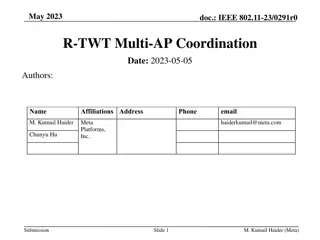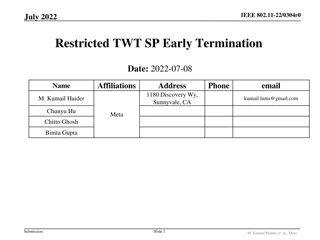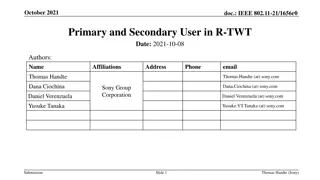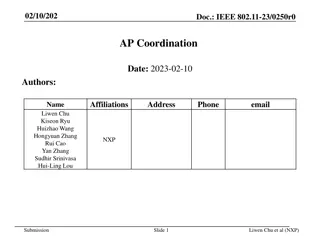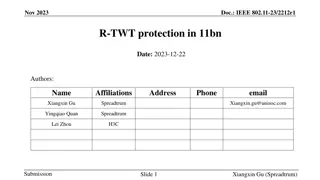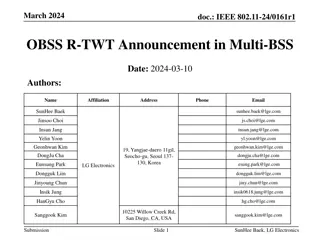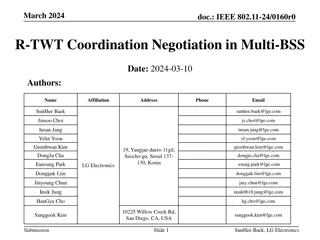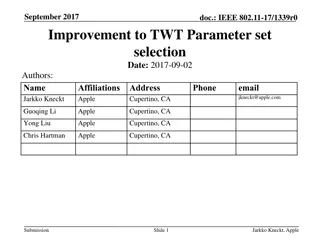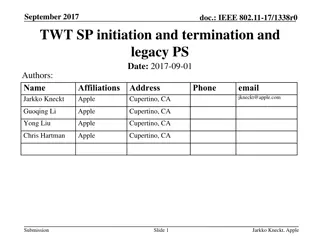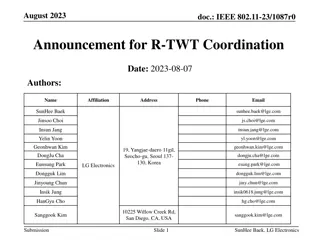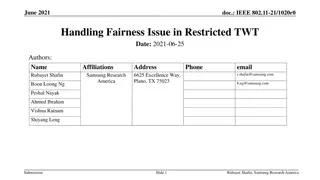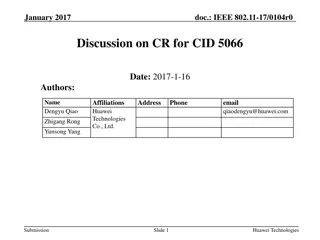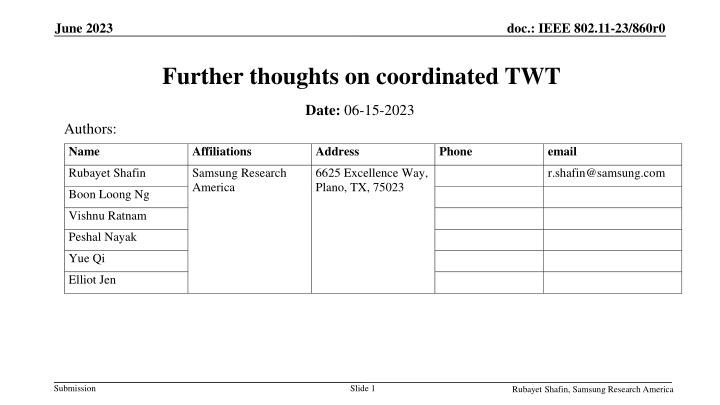
Coordinated TWT: Framework for Multi-AP Coordination in IEEE 802.11-23
Explore the framework for Coordinated Target Wake Time (TWT) in IEEE 802.11-23, focusing on Multi-AP Coordination to enhance network efficiency and reduce interference. Discover the phases of TWT coordination and the significance of MAP TWT Announcement and Negotiation in improving performance for UHR SG and IEEE 802.11bn standards.
Download Presentation

Please find below an Image/Link to download the presentation.
The content on the website is provided AS IS for your information and personal use only. It may not be sold, licensed, or shared on other websites without obtaining consent from the author. If you encounter any issues during the download, it is possible that the publisher has removed the file from their server.
You are allowed to download the files provided on this website for personal or commercial use, subject to the condition that they are used lawfully. All files are the property of their respective owners.
The content on the website is provided AS IS for your information and personal use only. It may not be sold, licensed, or shared on other websites without obtaining consent from the author.
E N D
Presentation Transcript
June 2023 doc.: IEEE 802.11-23/860r0 Further thoughts on coordinated TWT Date: 06-15-2023 Authors: Name Affiliations Address Phone email Rubayet Shafin Samsung Research America 6625 Excellence Way, Plano, TX, 75023 r.shafin@samsung.com Boon Loong Ng Vishnu Ratnam Peshal Nayak Yue Qi Elliot Jen Submission Slide 1 Rubayet Shafin, Samsung Research America
June 2023 doc.: IEEE 802.11-23/860r0 Abstract In this contribution, we follow up from our previous contributions on TWT- based multi-AP coordination [1-3]. Submission Slide 2 Rubayet Shafin, Samsung Research America
June 2023 doc.: IEEE 802.11-23/860r0 Recap Multi-AP (MAP) Coordination is one of the key features considered for UHR SG and IEEE 802.11bn. Apart from the coordinated OFDMA, coordinated beamforming, joint transmission, and coordinated spatial reuse, the Coordinated TWT (C- TWT) is also considered one of the strongest candidates for MAP coordination mechanism [1-9]. Terminologies: TWT Sharing AP: The AP that has (or intends to have) a TWT schedule/agreement in its BSS and initiates a TWT coordination procedure with OBSS APs for better protection (e.g. increase channel access opportunity or reduce OBSS interference) of the TWT SPs TWT Shared AP: The recipient of the TWT coordination request from the TWT sharing AP. Different modes of TWT coordination were discussed [3] Client-centric TWT coordination: catering to specific STA to reduce its perceived OBSS interference during the TWT SPs Network-wide coordination: performed to assist a group of a STAs in a BSS (e.g, for faster channel access for TWT scheduled STAs) The need for TWT coordination for the protection of R-TWT SPs was highlighted, and different levels of R-TWT protection were discussed In this contribution, we discuss the framework for TWT-based multi-AP coordination. Submission Slide 3 Rubayet Shafin, Samsung Research America
June 2023 doc.: IEEE 802.11-23/860r0 Framework for Coordinated TWT The baseline individual TWT is established using a negotiation between the two STAs. The baseline broadcast/restricted TWT is established through an advertisement by the AP followed by a negotiation between the AP and the STA. Multi-AP TWT coordination calls for additional steps. The overall phases for TWT coordination can be listed as MAP TWT Announcement MAP TWT Negotiation Intra-BSS TWT Announcement Intra-BSS TWT Negotiation Maintenance of a TWT schedule/agreement Termination of TWT coordination Intra-BSS TWT Announcement (B-TWT/R-TWT) MAP TWT Announcement MAP TWT Negotiation Intra-BSS TWT Negotiation TWT Coordination Termination Maintenance 11bn 11bn Baseline + 11bn Baseline + 11bn Baseline + 11bn 11bn Submission Slide 4 Rubayet Shafin, Samsung Research America
June 2023 doc.: IEEE 802.11-23/860r0 MAP Announcement and MAP Negotiation MAP TWT announcement: During this phase, the TWT sharing AP can identify the other APs that are willing to participate in TWT coordination. Basic capability and coordination information (e.g. modes of TWT coordination (iTWT/bTWT/rTWT)) can be announced during this phase. If a neighboring AP is willing and prepared to participate in the TWT coordination, it can inform the TWT sharing AP by responding to the announcement received from the TWT sharing AP. This phase essentially forms a TWT coordination group. AP1 (TWT sharing AP) AP2 AP3 AP4 MAP TWT Negotiation: During this phase, TWT parameters for MAP coordination are decided among the participating APs. The sharing AP can send a TWT coordination request to the other APs in the TWT coordination group. Along with the C-TWT parameters, the request can also contain types of coordination. For example, if the negotiation is for an R-TWT, then the sharing AP can include the level of protection it requests from the shared APs [see [3]]. Upon receiving the request, the shared AP can either accept/reject the request or suggest an alternative set of C-TWT parameters. MAP Announcement MAP Negotiation C-TWT Response C-TWT Request C-TWT Announcement C-TWT Preparedness Figure: Illustration of frame exchanges for MAP TWT announcement and negotiation. Assumes wireless MAP coordination. For managed networks, frame exchanges can happen through the central controller. Rubayet Shafin, Samsung Research America Submission Slide 5
June 2023 doc.: IEEE 802.11-23/860r0 Coordinated TWT Agreement In the baseline, a TWT agreement/schedule is set up between an AP and a non-AP STA when both agree on a complete set of TWT parameters. For multi-AP TWT coordination, since each participating AP has its local constraints in its BSS, it may not be possible for all the TWT shared APs to comply with the entire coordinated TWT parameter set requested by the TWT sharing AP. From the sharing AP s perspective, in certain scenarios, even partial fulfillment of the C-TWT request by the shared APs can be useful (for example, in the R-TWT context, this can on average improve the channel access opportunities for the members STAs) A shared AP can skip one or more C-TWT SP(s) while respecting others (i.e. difference in the wake interval for the coordinated TWT) A shared AP can terminate participation in the TWT coordination earlier than the requested time (i.e. difference in the TWT persistence parameters) New parameters can be introduced to provide additional degrees of freedom in the negotiation for TWT coordination between the sharing AP and the shared APs (TBD). TWT IE Beacon TWT SP in BSS1 TWT SP in BSS1 TWT SP in BSS1 TWT SP in BSS1 AP1 TWT Figure: An illustration of a shared AP providing coordination for every other TWT SP corresponding to the B-TWT schedule requested by the AP. Sharing AP TWT IE Beacon TWT SP in BSS2 TWT SP in BSS2 AP2 TWT Shared AP Submission Slide 6 Rubayet Shafin, Samsung Research America
June 2023 doc.: IEEE 802.11-23/860r0 Intra-BSS C-TWT Procedures When a TWT shared AP agrees to coordinate with the TWT sharing AP, based on the nature of the agreement, the shared AP can take different approaches for notifying or (announcing for) the STA(s) in its BSS* Target Wake Time = T1 (based on AP1's TSF1) Broadcast TWT IE R-TWT SP in BSS1 Beacon Approach-1: The shared AP, in notifying the member(s) of its own BSS, can make a distinction between its own TWT (i.e. the TWTs generated and maintained by the shared AP for its BSS) and the coordinated TWT that the shared AP is participating in. The shared AP can dictate the behavior expected from its associated STAs during the SPs of the coordinated TWT. Example 1: if the MAP coordination is for an individual TWT and the sharing AP requests to minimize the interference towards a victim STA in the sharing AP s BSS during the C- TWT SP, then the shared AP can indicate to the interfering STA associated with the shared AP to avoid transmission during the C-TWT SPs**. Example 2: if the MAP coordination is for an R-TWT, the shared AP can announce the corresponding C-TWT schedule in its BSS, but add a marker in the schedule to distinguish it from its own R-TWT schedule. The shared AP can establish different rules in regard to this C-TWT such as membership management, and differentiated TXOP ending rules [see Types of R-TWT protection in [3]]. R-TWT Basic Trigger DL PPDU BA AP1 TWT sharing AP PS-Poll BA STA1 Doze R-TWT member STA in BSS1 Broadcast TWT IE R-TWT SP in BSS2 Beacon Target Wake Time = T2 (based on AP2s TSF) Basic Trigger DL PPDU R-TWT BA AP2 TWT shared AP PS-Poll BA STA2 R-TWT member STA in BSS2 Approach-2: The shared AP Makes no distinction between its own TWT and the coordinated TWT it is participating in. More applicable for B-TWT/R-TWT based coordination The shared AP advertises the C-TWT schedule in its BSS as if the schedule is its own TWT schedule (TWT timing param would be adapted based on the shared AP s TSF). The STAs in the shared AP s BSS would be agnostic to whether the advertised schedule is a C-TWT schedule or not, and can seek membership in the coordinated schedule. Figure: An illustration of a shared AP advertising and establishing a coordinated R-TWT schedule in its own BSS. In the figure, STA1 is associated with AP1, and STA2 is associated with AP2; the figure assumes the TSFs of the two APs are synced or the TSF difference is known. * Sharing AP s intra-BSS TWT operation can follow baseline procedure. ** If the shared AP itself is the interfering STA, it can create a null towards the victim STA during the C-TWT SP. Submission Slide 7 Rubayet Shafin, Samsung Research America
June 2023 doc.: IEEE 802.11-23/860r0 C-TWT Parameter Update (Maintenance) and Termination When the TWT sharing AP intends to update the parameters for the coordinated TWT, this update needs to be conveyed to the shared APs (and accordingly to the shared AP s BSSs) AP1 TWT sharing AP Option-1: Implicit Notification Shared APs monitor the sharing AP s beacons where the sharing AP announces any changes or upcoming updates to the TWT parameters Works for B-TWT/R-TWT but does not for I-TWT since updates are not broadcasted. Whenever the sharing AP announces the update to the C-TWT schedule, the shared APs also adapt to the changes and accordingly notify their respective BSSs (using baseline procedure) If the updated parameters don t work for a shared AP, the shared AP can terminate the coordination and notify the sharing AP**. AP2 TWT shared AP Reject Update AP3 TWT shared AP Accept Update Alternate Upate AP4 TWT shared AP Accept Update Alternate Update Option-2: Explicit Notification (preferred) The TWT sharing AP explicitly notifies each of the shared AP about the impending changes in the C-TWT parameters. The shared AP can respond with acceptance, rejection, or suggested parameters If the shared APs accept the changes in the C-TWT parameters, they can subsequently notify their respective BSSs (using baseline procedure). If a shared AP rejects the TWT parameters update, the TWT coordination is terminated for that shared AP. The shared AP can also notify its BSS as needed. C-TWT Parameter Update Response C-TWT Parameter Update Notification Figure: An illustration of C-TWT parameter update negotiation. The sharing AP notifies the shared AP of its intention to change the C-TWT parameters. AP2 rejects to comply with the updated C-TWT and accordingly, its C-TWT coordination is terminated. AP3 and AP4 suggest alternative sets of parameters for the updates. The sharing AP sends new requests to AP3 and AP4 with the suggested parameters, and subsequently AP3 and AP4 accept the parameter update. * Either the sharing AP or the shared AP can terminate the TWT coordination at any time but need to notify the other party. Submission Slide 8 Rubayet Shafin, Samsung Research America
June 2023 doc.: IEEE 802.11-23/860r0 Summary Coordinated TWT is one of the strongest candidates for 802.11bn Simpler to implement Multi-AP TWT coordination mechanism can be built on top of the baseline individual and broadcast TWT procedures. The coordinated TWT would require some additional steps (on top of baseline) MAP announcement MAP negotiation Should allow partial support/coordination Enhancement to intra-BSS TWT announcement and negotiation Enhancement to TWT maintenance. Submission Slide 9 Rubayet Shafin, Samsung Research America
June 2023 doc.: IEEE 802.11-23/860r0 References [1] IEEE 802.11-21/1046r0, Multi-AP: TWT Information Sharing , Rubayet Shafin, et.al., July 2021. [2] IEEE 802.11-22/1530r1, Multi-AP coordination for next-generation Wi-Fi , Rubayet Shafin, et.al., Sept 2022. [3] IEEE 802.11-23/932r0, Follow-up on TWT-based Multi-AP Coordination , Rubayet Shafin, et.al., May 2023. [4] IEEE 802.11-23/226r1, Coordination of R-TWT for Multi-AP Deployment , Abdel Karim Ajami, et.al., April 2023 [5] IEEE 802.11-23/250r0, AP coordination with R-TWT , Liwen Chu, et.al., April 2023 [6] IEEE 802.11-23/291r0, R-TWT Multi-AP Coordination , Muhammad Kumail Haider, et.al., May 2023. [7] IEEE 802.11-23/297r0, r-TWT for Multi-AP , Laurent Cariou, et.al., April 2023 [8] IEEE 802.11-23/355r0, Enhanced rTWT and MAP operation , Hanqing Lou, et.al., May 2023 [9] IEEE 802.11-23/771r0, Coordinated R-TWT Protection in Multi-BSS , SunHee Baek, et.al., June 2023. Submission Slide 10 Rubayet Shafin, Samsung Research America


